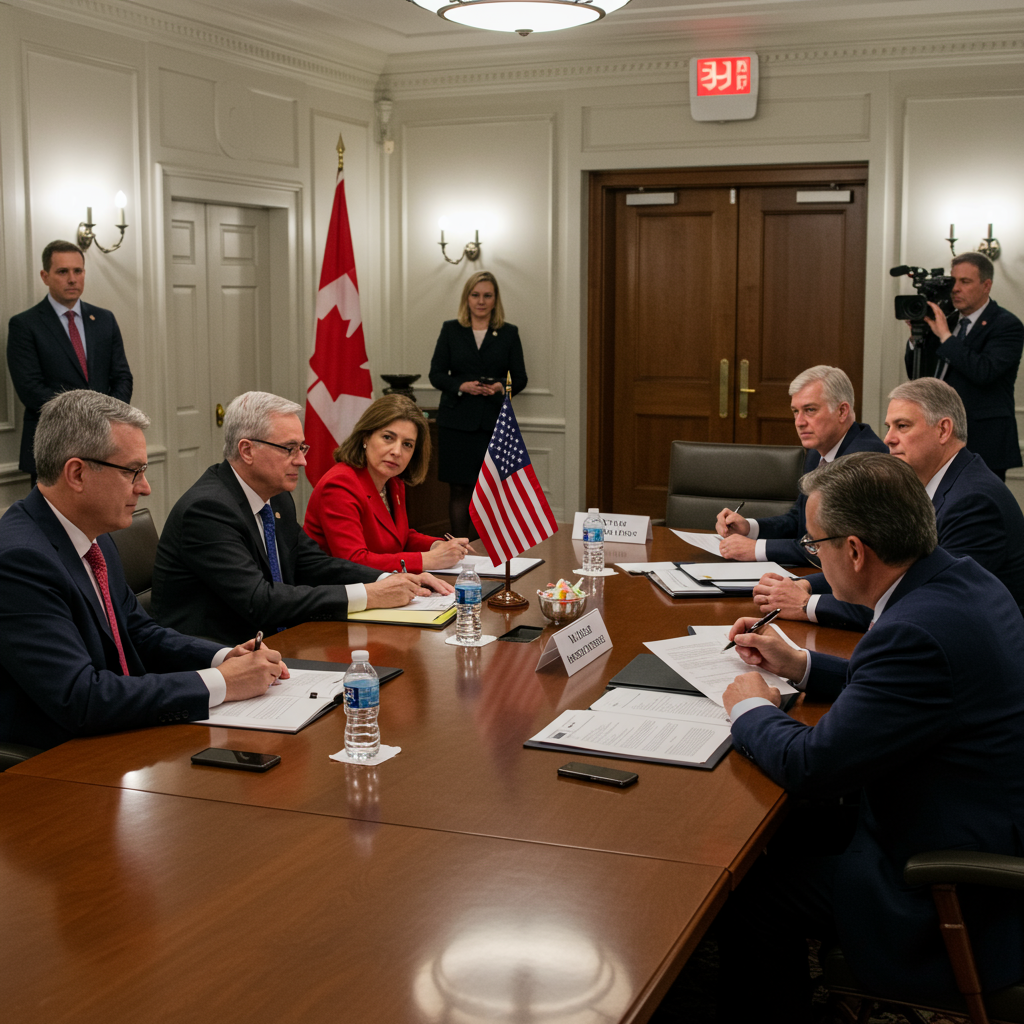In a dramatic eleventh-hour decision, canada has rescinded its controversial digital services tax (DST) targeting large American technology companies. The move, announced just hours before the first tax payments were due, clears the path for urgent trade negotiations to resume with the United States. This reversal follows intense pressure from the Trump administration, which had explicitly linked the tax to stalled trade talks and threatened retaliatory tariffs. The rapid de-escalation underscores the critical importance of the US economic relationship for Canada and sets the stage for complex discussions aimed at a broader trade agreement.
The Digital Tax Showdown: What Happened?
Canada’s proposed Digital Services Tax was designed to levy a 3% charge on gross Canadian revenues earned by major digital platforms. This applied to companies exceeding C$20 million in Canadian revenue and C$1.1 billion globally. Key US tech giants like Amazon, Meta, Google, and Apple were among the primary targets, alongside other digital businesses such as Uber and Airbnb. The tax aimed to address concerns that large multinational tech firms were generating significant income from Canadian users but paying minimal corporate tax in the country due to international tax structures that allow profits to be routed through low-tax jurisdictions. Ottawa had initially announced the tax in 2020, intending it as a temporary measure until a global multilateral framework, likely through the OECD, could be established. Notably, the Canadian tax was planned to apply retroactively to revenues generated from January 2022, creating a substantial, immediate financial obligation for affected companies.
Why Canada Pursued a Digital Services Tax
The rationale behind Canada’s DST mirrored similar efforts by many countries globally, including the UK. Governments worldwide grapple with how to fairly tax highly profitable digital businesses that operate across borders without a significant physical presence. Canada’s finance minister stated the tax was necessary because many large tech companies were not otherwise paying adequate tax on revenues earned from Canadian consumers and advertisers. Canada’s official preference remained for a multilateral solution, believing a coordinated global approach would be the most effective and sustainable way to ensure digital revenues are taxed appropriately where value is created. However, progress on a global agreement had been slow, prompting Canada and others to consider unilateral measures like the DST.
US Pressure Mounts: A “Blatant Attack”
The United States government, particularly under President Donald Trump, vehemently opposed Canada’s proposed digital tax. US officials viewed it as unfairly targeting American companies and a potential barrier to trade. President Trump had recently suspended trade negotiations with Canada, describing the tax as a “direct and blatant attack” on the US economy. He warned of significant consequences, including the possibility of imposing higher tariffs on Canadian imports. US Commerce Secretary Howard Lutnick echoed this sentiment, stating the tax would have been a “deal breaker” for any potential trade agreement. White House economic adviser Kevin Hassett later confirmed that rescinding the tax was key to restarting negotiations. This strong stance from Washington put immense pressure on Ottawa.
The Swift Reversal and Resumption of Talks
Facing the imminent deadline for the first DST payments and the breakdown of trade talks, Canada opted for a rapid retreat. Prime Minister Mark Carney’s office confirmed the decision on Sunday, following a phone call with President Trump. Canadian Finance Minister François-Philippe Champagne announced that legislation would be introduced to repeal the Digital Services Tax Act, effectively halting collection of payments. The decision was explicitly framed as a necessary step “in anticipation” of reaching a broader economic and security agreement with the US. This climbdown, hours before the tax’s effective collection date, highlights the urgency and the significant leverage the US holds in trade relations with Canada, given that three quarters of Canada’s goods exports, worth over $400 billion annually, go to the US.
Implications for US-Canada Trade Relations
Canada’s decision to drop the DST has successfully reopened the door for trade negotiations, which President Trump had paused. Both leaders have set an ambitious target of reaching a new trade deal by July 21st, building on discussions held at the recent G7 summit. The tax dispute was a significant irritant, dating back even to the previous Biden administration, but its removal allows negotiators to focus on other areas. However, the path forward is expected to be complex. The Trump administration has signaled it expects Canada to make further concessions on other lingering trade issues, potentially including agricultural tariffs, which have been a long-standing point of friction.
Adding pressure to the timeline is the looming July 9th deadline. President Trump had imposed temporary halts on some global tariffs but indicated they could resume unless new trade agreements were reached. Resolving key trade tensions before this deadline is a priority for Canadian officials seeking to avoid the imposition of new duties that could impact various sectors of the Canadian economy.
Economic Stakes and Expert Analysis
The financial implications of the tax and trade dispute are considerable. The DST was estimated to cost affected tech giants over C$2 billion (approximately $1.5 billion USD) in its first year due to the retroactive application. Canada’s Parliamentary Budget Officer had projected the tax could generate around C$7.2 billion in revenue over five years, a figure Ottawa now forfeits. The economic power imbalance between the two nations—Canada sends the vast majority of its exports south, while taking a much smaller share of US production—further underscores the leverage Washington possesses.
Experts have offered varied analyses of Canada’s handling and the outcome. Michael Geist, a law professor at the University of Ottawa who has written extensively on the DST, criticized the Canadian government’s management of the issue over five years. He pointed to factors like the retroactive nature of the tax and an alleged failure to adequately address bipartisan US concerns. Daniel Béland, a political science professor at McGill University, interpreted the tax reversal as a significant political victory for President Trump and a clear instance of Canada yielding to pressure from Washington, effectively achieving the outcome desired by major tech corporations.
The Broader Digital Tax Landscape
While Canada has paused its unilateral DST, the global push to reform international corporate taxation for digital companies continues. Many countries still believe the current system is outdated for the digital age. Discussions at the OECD aim to develop a two-pillar solution: Pillar One addresses where profits are taxed, reallocating some taxing rights to market jurisdictions (where users are), while Pillar Two introduces a global minimum corporate tax rate. Canada’s stated preference was always for such a multilateral solution, and dropping its unilateral tax could be seen as aligning with this long-term goal, potentially in anticipation of renewed international progress or as a concession to keep trade lines open while multilateral talks evolve.
The American Chamber of Commerce welcomed Canada’s decision, calling it “constructive” and suggesting it allows both countries to focus on strengthening their economic partnership. However, the episode highlights the volatility in US-Canada relations under the current US administration and the significant challenges small- and medium-sized trading partners face when dealing with the US’s use of tariff threats as a negotiating tool.
Frequently Asked Questions
Why did Canada want to tax US tech companies initially?
Canada proposed the digital services tax (DST) to address concerns that large multinational technology companies operating in Canada generated significant revenue from Canadian users but paid little corporate tax in the country. The tax, a 3% levy on Canadian revenue above certain thresholds, was intended to ensure these companies contributed fairly to the Canadian tax base, particularly as progress on a global multilateral tax solution had been slow. It was viewed as a temporary measure until an international agreement could be reached.
What specifically triggered Canada’s decision to drop the digital tax?
Canada’s decision to drop the digital tax was primarily triggered by pressure from the United States and the breakdown of trade negotiations. US President Donald Trump had explicitly linked the tax to stalled trade talks, calling it a “blatant attack” and threatening tariffs on Canadian goods. With the first tax payments due within hours, Canada made the swift reversal following a phone call between Prime Minister Mark Carney and President Trump, stating the move was necessary to allow trade talks to resume and progress towards a new bilateral economic agreement.
What are the next steps for US-Canada trade talks after the tax reversal?
With the digital services tax removed as a major impediment, Canada and the US have resumed trade negotiations. The immediate next step is to work towards reaching a broader trade agreement, with leaders setting a target date of July 21st. However, discussions are expected to cover other contentious areas, potentially including agricultural tariffs. The ongoing negotiations are also taking place under the shadow of a looming July 9th deadline, by which President Trump may reimpose or escalate tariffs on countries that haven’t reached new trade deals, adding urgency to the process.
The Road Ahead
Canada’s decision to abandon its digital services tax is a significant development that prioritizes reopening crucial trade dialogue with the United States. While it removes a key point of contention, it also represents a political concession and foregoing potential tax revenue. The focus now shifts to the negotiating table, where officials from both countries will navigate a range of complex economic issues under tight deadlines and the ever-present possibility of tariff threats. The success of these renewed talks will be critical for the deeply interconnected economies of the North American neighbors.


